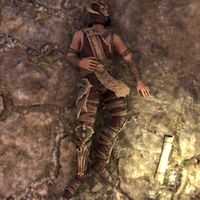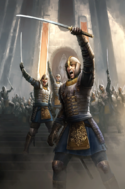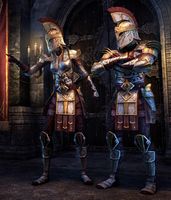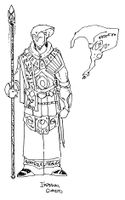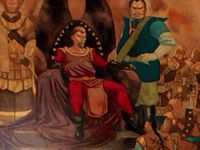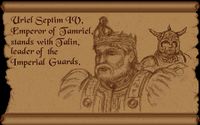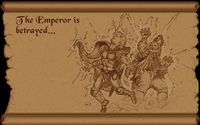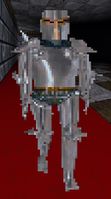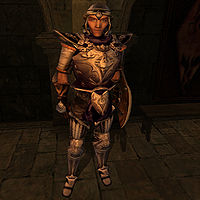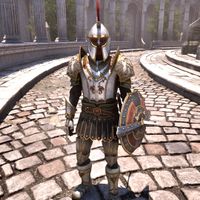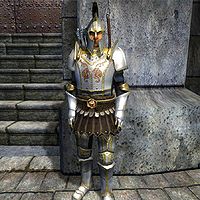Lore:Imperial Guard
The Imperial Guard, also referred to as the shadow legion,[1] were charged with the sole task of ensuring the personal safety and defense of the Tamrielic Emperors and various of their direct representatives across the provinces.[2] The Guard were known as the greatest warrior-mages in Tamriel,[3] and existed as an elite unit under the Imperial Legion umbrella.[2] An individual of the guard is known as a janisiere.[nb 2]
While the term "Imperial Guard" is often used to describe common guardsmen found throughout the Empire, the elite unit of bodyguards are a separated unique order who directly serve in the Emperor's courts guarding royals.[2] There was a traditional rivalry set between the Imperial Guard their counterparts in the regular Legions.[2]
Contents
History[edit]
Age of Heroes[edit]
Consistent with more contemporary times, the Imperial Guard of the Age of Heroes that protected the Emperors as bodyguards.[4][5] During the reign of the Longhouse Emperor Moricar, the Imperial Guard consisted of mostly Reachfolk. Moricar's Guard had werewolves among its ranks.[6] Following the fall of the dynasty, some the guard returned to the Reach.[7][8][9]
The Proving[edit]
The Battlespire was utilized for centuries as a Testing Facility and Proving Ground for those who wished to join the Imperial Guard. Recruits of this Imperial Battle College were known as Potentials and were usually identified as preteens. These Potentials learn about magic, the art of magical and martial warfare, as well as contemporary studies. Every year there was a Potentials Battle Tourney, where the first and second place winners are allowed to enter the Battlespire Proving Ground.[10][11][3] Only those who could prove themselves by successfully mastering the challenges of Battlespire were chosen for the Emperor's Imperial Guard.[3][11]
Tiber War[edit]
Circa 2E 864, the Imperial Guard were actively serving Emperor Tiber Septim.[12][UOL 1]
Queenmakers[edit]
Circa 3E 3, General Symmachus of the Imperial Army and Imperial Guards under his command, rode to Skyrim to collect a ward of the Septim Empire: Princess Barenziah of Clan Ra'athim and install her as the provincial Queen of Morrowind, to rule from the seat of Mournhold in Almalexia City. As ordered by his Emperor, General Symmachus would set aside his Imperial General and Governor titles to serve as Barenziah's Prime Minister, and even went on to marry her.[13]
Imperial Guard remained stationed within Mournhold for several centuries.[13]
In the time following the theft of the Staff of Chaos from Mournhold, Circa 3E 376, the relationship between the Morrowind Queendom and the Septim Empire slowly deteriorated. Imperial taxes were raised and quotas were increased with each passing year. Prime Minister Symmachus believed the Emperor had some suspicions that the Prime Minister had some role in the Staff's theft; in order to prove his loyalty to the Dragon Throne he made every effort to comply with the with the escalating demands. He lengthened working hours and raised tariffs, and even made up some of the difference from both the royal exchequer and the family's own private holdings. But the levies multiplied, and commoners and nobles alike began to complain. Symmachus sent his lady wife Barenziah to plead with the Emperor, and even said that she could tell the Emperor that: without his aid, the Empire would have never begun, and that he can bring about its fall if need be. Eventually, a rebel revolt ensued in the city, with the Imperial Guard allegedly joining the rebels, somehow resulting in Symmachus's death Circa 3E 391.[13]
Imperial Simulacrum[edit]
Circa 3E 389, General Talin Warhaft was leader of Imperial Guard. Warhaft and others of the Emperor's Imperial Guard were banished into Oblivion by the Imperial Battlemage of Tamriel, Jagar Tharn, and physically replaced by doppelgangers.[14][15] Tharn used these faux Guards as puppets serving his own machinations. When General Warhaft was saved by the Eternal Champion and returned to Tamriel, he seemingly resumed his duties.[14]
The Battlespire was partially destroyed by the forces of Mehrunes Dagon during the Imperial Simulacrum. However, upon Restoration, Emperor Uriel chose to retake the destroyed facility,[16] despite advice from his treasury to not.[11] However it remained inactive as an Imperial Proving Ground.[17]
The Decline[edit]
In the later Third Era,[nb 1] Lady Allena Benoch became head of the Emperor's Imperial Guard under Uriel VII. She neither confirms nor denies her role in the removal of Calaxes Septim as Archbishop of The One while serving in the Guard.[18]
Circa 3E 427, Vedam Dren, Duke of Vvardenfell, had Imperial Guard assigned to his service.[19]
When Emperor Uriel Septim VII was assassinated by the Mythic Dawn,[20] the Imperial Guard joined the regicide investigation alongside the: Elder Council, Imperial Legions, Arcane University, and Imperial Battle College.[21]
Circa 4E 48, the Imperial Guard was still in operation, regarded as professionals compared to the Penitus Oculatus.[22]
Notable Members[edit]
- Zuuk, knight of the Imperial Guard circa 1E 2920[23]
- Talin Warhaft, General of the Imperial Guard circa 3E 389
- The Apprentice, high member of the Imperial Legions circa 3E 399[11]
- Josian Kaid, high member of the Imperial Legions circa 3E 399[11]
- Vatsaha Trenelle, high member of the Imperial Legions circa 3E 399[11]
- The Agent, may have once been a member of the Imperial Guard serving in Cyrodiil City[24]
- Allena Benoch, head of the Emperor's Imperial Guard circa 3E 427[18]
Known Ranks[edit]
The exact hierarchy of ranks, the nuances between them, and the trajectory of advancement, has not been spelled out, but can generally be understood as categorized below.
Subgroups[edit]
Blades Guard[edit]Since the days of Emperor Tiber Septim I,[25] a selected few belonging to the Imperial Order of Blades served publically in the Imperial Guard as the Dragonborn Emperors' ceremonial honor guard.[26][27] After the last Dragonborn Emperor retired from the world, the Blades Guard branch eventually dissolved, and was later replaced by the Penitus Oculatus.[28] | |
Dragon riders[edit]The Imperial Guard are said to have maintained an elite unit of Dragon riders during the late Third Era, with at least one member of this group being known. The Dragons that served were paid in spoils and placed into the protective custody of the Empire at secret Imperial strongholds (such as the Battlespire). In return for the protection of the Empire and booty, the Dragons offered their services as wartime soldiers to the Imperial Legions when called upon.[29][30][31][UOL 2] |
Gallery[edit]
Notes[edit]
- Various Battlespire sources refer to "The Chronicles of Janisiere" as being an in-world book about the events of the game.[11][32] What "Janisiere" means in the context of The Elder Scrolls has not been defined, and seems to have been uniquely invented for the series. But when the invented word's roots are compared to real world languages, Janisiere seems to be an etymological mashup of "janissary" (a member of elite infantry units that make up the household guard of an Ottoman sultan) and "-iere" (a feminine suffix used for an occupation or role in some languages, seen in words like chevaliere or brigadiere); with this real world etymology in mind, the use of the word "Janisiere" for the title of "The Chronicles of Janisiere" makes sense, given that the game's narrative is about a protagonist seeking to join the Emperor's personal guardians: the Imperial Guard.
References[edit]
- ^ Battlespire Intro Narration
- ^ a b c d Imperial Guard topic during Morrowind
- ^ a b c Battlespire E3 1997: STORYBAT.TXT
- ^ a b Events of ESO
- ^ a b Imperial Guard Centurion Uniform description in ESO
- ^ Senan in ESO
- ^ Arana's dialogue in ESO
- ^ Senan's Note quest item description in ESO
- ^ Arloakh's dialogue in ESO
- ^ a b Meet the Character - Lucilla Caprenia — Martus Tullius
- ^ a b c d e f g Battlespire Athenaeum
- ^ Redguard Introduction
- ^ a b c d The Real Barenziah — Anonymous
- ^ a b c Events of Arena
- ^ French version of Arena's Manual Intro Story
- ^ Tamrielic Lore — Yagrum Bagarn
- ^ The Doors of Oblivion — Seif-ij Hidja
- ^ a b c Words and Philosophy
- ^ Events of Morrowind
- ^ Events of Oblivion
- ^ Assassination!
- ^ The Infernal City — Greg Keyes
- ^ 2920, The Last Year of the First Era
- ^ Daggerfall Player Character Background Histories
- ^ The Ancient Watcher quest in Daggerfall
- ^ Jauffre's dialogue during Oblivion
- ^ The Book of the Dragonborn — Prior Emelene Madrine
- ^ Legends Card Lore - Penitus Oculatus Agent
- ^ The Weir Gate level in Battlespire
- ^ Starlover's Log — Samar Starlover
- ^ Nafaalilargus' conversation with Cyrus in Redguard
- ^ Elder Scrolls Codex: History
Note: The following references are considered to be unofficial sources. They are included to round off this article and may not be authoritative or conclusive.
Note: The following references are derived from fan translations of terms and phrases in The Elder Scrolls which are seemingly derived from real world languages, and thus are entirely unauthoritative in nature.

